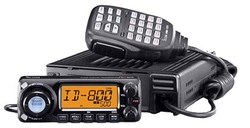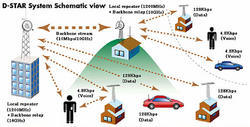D-Star : Digital Smart Technologies for Amateur Radio
D-STAR, For the Second Century of Amateur Radio





D-STAR stands for Digital Smart Technology for Amateur Radio. The purpose of D-STAR is to allow HAM Radio operators to speak further and clearer using digital voice while sending data from 1200 BPS on up at the same time. The D-STAR system covers communications on HF, VHF, and UHF radio bands while defining interfaces for both radios, repeaters, Internet interconections, and PC interfaces.
According to Icom America: D-STAR transfers both voice and data via digital encoding over the 2 m (VHF), 70 cm (UHF), and 23 cm (1.2 GHz) amateur radio bands. Voice is encoded as a 3600 bit/s data stream using AMBE* encoding. Data streams are sent at 9600 bit/s over the 2 m and 70 cm bands and at 128k bps over the 23 cm band. Radios providng data service use a RS-232 or USB connection for low speed data and Ethernet for high speed connections to allow easy interfacing with computer equipment.
*NOTE: AMBE is an acronym for "Advanced Multi-Band Excitation": A speech coding standard developed by Digital Voice Systems, Inc. It is used by the Inmarsat and Iridium satellite telephony systems, certain channels on XM Satellite Radio,G4GUO protocol for high frequency amateur radio and is the vocoder for OpenSky Trunked Radio Systems.
ARE YOU D-STAR READY? CLICK THE D-STAR READY ICON BELOW FOR D-STAR CALL SIGN REGISTRATION SO YOU CAN BE D-STAR READY TOO!
D-Star Compatable Equipment
Although Icom is the first to support D-STAR, any company can produce equipment to support this protocol. The equipment known to interoperate with D-STAR systems includes:
- Radios
- ICOM ID-1 - 1200 MHz (23 cm) Digital Tranceiver
- ICOM ID-800H - VHF (2 m) & UHF (70 cm) Digital Tranceiver
- ICOM IC-2820 - Dual display VHF (2m) & UHF (70cm) w/built-in GPS (with D-Star option installed
- ICOM IC-91AD - VHF & UHF Dual-Band Handheld Tranceiver
- ICOM IC-92AD - VHF & UHF Handheld Tranceiver (not yet FCC approved, expected to be available in early 2008)
- ICOM IC-V82 - VHF Handheld Transceiver
- ICOM IC-U82 - UHF Handheld Transceiver
- ICOM IC-2200H - VHF Mobile Transceiver
- Repeaters
- ICOM ID-RP2C - Controller
- ICOM ID-RP2V - 1.2 GHz (23 cm) Voice Repeater
- ICOM ID-RP2D - 1.2 GHz (23 cm) Data Repeater
- ICOM ID-RP2000V - UHF (70 cm) Voice Repeater
- ICOM ID-RP4000V - VHF (2 m) Voice Repeater
Definition of Terms Associated with D-Star
Definitions
Air Link: The portion of data transmission that takes place as a radio signal. The D-STAR air link includes both modulation methods and data packet construction.
Area: The geographical region served by one D-STAR repeater.
Authorization: Adding a user to the D-STAR registry.
Bridge: A connection between just two devices, such as between two ID-1 transceivers.
Client: A program that requests data (programs, Web pages, documents, etc.) from servers.
Codec: Code/Decode, a circuit or program that translates an analog signal to and from digital form, usually refers to an audio signal, such as voice or music. Different codecs, such as AMBE or MP3, have different rules for the translation between analog and digital.
Controller: The part of a D-STAR repeater that handles and routes the voice and data streams either between modules or between modules and the gateway.
DD (Digital Data): The D-STAR high-speed digital data signal.
DV (Digital Voice): The D-STAR digital voice + low-speed data signal.
EchoLink®: (www.echolink.org/) and IRLP (Internet Relay Linking Project - www.irlp.net/ systems that allow repeaters to share digitized voice signals using Voice-Over-Internet Protocol (VOIP) technology.
Encapsulate: To incorporate data packets from one protocol inside the data packets of another.
Ethernet: The set of protocols that control local area network (LAN) connections, described by the IEEE 802.3 standard.
FEC: Forward Error Correction, the process of adding information to data so that the receiver can correct errors caused by the transmission process.
Gateway: The part of a D-STAR repeater that connects the controller to other gateways via the Internet.
IP: Internet Protocol, the protocol that controls how data packets are exchanged on the Internet.
IMBE: (Improved Multi Band Excitation) is a proprietary vocoder developed by Digital Voice Systems, Inc. (DVSI).
Module: A D-STAR module is the part of a D-STAR repeater that implements voice or data communication over the air.
Register: Capture the call sign of a received signal and post it to the system registry for other D-STAR repeaters to use for the purposes of routing calls.
Registry: A shared data base of authorized user call signs and gateways.
Route: To direct data packets to specific destinations.
Server: A computer that supplies data (programs, Web pages, documents, etc.) to clients when requested.
vocoder: (name derived from voice encoder, formerly also called voder) is a speech analyzer and synthesizer. It was originally developed as a speech coder for telecommunications applications in the 1930s, the idea being to code speech for transmission. Its primary use in this fashion is for secure radio communication, where voice has to be digitized, encrypted and then transmitted on a narrow, voice-bandwidth channel. The vocoder has also been used extensively as an electronic musical instrument.
Zone: A group of D-STAR repeaters linked together and connected to other D-STAR systems by a single gateway.
D-Star San Diego Group Ushering in a New Era
It was back in late August 2006 that Bob Randall, KE6YRU, first introduced his digital UHF repeater to the San Diego amateur radio community. That first repeater consisted of two ID-800H dual-band mobiles and an analog repeater controller set up on his coordinated frequency pair. While it was modest at best, it did give us a taste of what digital communications can bring to us. That first repeater renewed interest in digital communications, and Bob made presentations to various clubs in the area to demonstrate his repeater.
Those first steps were significant because it laid the foundation for what has now become the D-Star San Diego Group. This group, consisting of a Bob and a few local area amateur radio operators, made the investment in what promises to be a first for San Diego amateur radio. That two-mobile repeater has been replaced with a full-blown D-Star repeater, intergrating digital voice and digital data on that UHF frequency pair. Soon to follow are digital repeaters on 2 meters as well as 1.2GHz.
In October of 2007, Bob moved from San Diego, CA to Indianapolis, IN. Instead of taking his repeater with him, he worked a deal with the PAPA SYSTEM to maintain the repeater on Mt. Woodson. The new ownership was a tremendous boost for D-Star in San Diego as Mt. Woodson now becomes an integral part of the PAPA SYSTEM's D-Star line-up, covering southern California with 6 D-Star repeaters (now 3 in San Diego County). The Mt. Woodson D-Star repeater was be the first in San Diego with access to the D-Star Gateway, ushering in a whole new chapter in San Diego D-Star History.Soon to follow was the Palomar Mountain D-Star repeater, also with gateway access, and finally the Mt. Otay D-Star repeater (no gateway at this time).
The frequency for the Mt Woodson D-Star repeater is 447.840 (-) and the call is KI6KQU B. The frequency for the Palomar Mountain D-Star Repeater is 445.860 (-) and the call is KI6MGN B. The frequency for the Mt. Otay D-Star Repeater is 446.980 (-) and the call is KW6HRO B.
Hope to hear you on the Mt. Woodson KI6KQU B D-Star repeater!

Click on image for ID-800H information and Specifications
This is the radio I am currently using for D-Star communications and experiments in the shack. The ID-800H features:
|
|
The Icom IC-92AD is a rugged 5 watt dualband HT with D-STAR built-in! Three RF power levels are available. It is built military tough and is submersible (1 meter 30 minutes). The 92AD features a multi-line display and keypad entry. Connect the optional HM-175GPS speaker mic to transmit position data - perfect for SAR.
NOTE:
The photo above is a design drawing. Production radios may look different. Information shown is preliminary and subject to change. More information will be posted shortly. Availability is slated for late 2007. The price has not been announced. 09/25/07
IcomInterface is now called DstarInterface - DstarTNC2
These programs, written by Pete Loveall (AE5PL), allow D-STAR users to use their radios as APRS trackers. The DstarInterface converts received D-STAR GPS position reports to the APRS format and sends them to the APRS-IS. DstarTNC2 lets you use an APRS-IS enabled client, like UI-View or Xastir, with the GPS position reporting feature of D-STAR radios.
DstarInterface is an adjunct of the javAPRSSrvr and DstarTNC2 can be downloaded at http://www.aprs-is.net/dstartnc2.htm.

